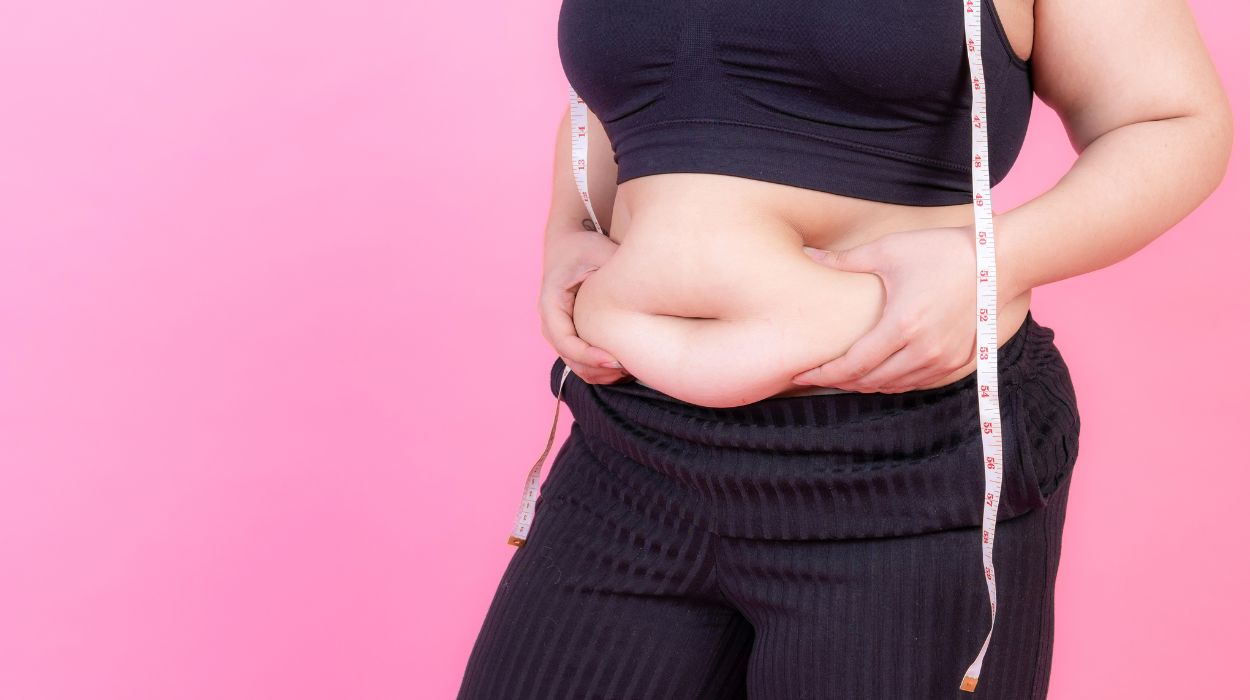As you monitor your overall health or progress during a weight loss journey, you may be interested in learning how to measure body fat. These measurements can give you insight into your body composition and give you a feel for your risks of developing certain diseases.
While many of the most reliably accurate methods for measuring body fat percentage are limited to clinical settings, some ways exist to estimate body fat percentage at home. So, what are some of the methods used to measure body fat? How can you interpret your results, and what are some ways to reduce your body fat?
We will investigate each of these questions in further detail.
How To Measure Body Fat: 5 Easy Ways
There are various options for measuring or estimating body fat. These include:
- Waist circumference.
- Skinfold calipers.
- Smart scales.
- Body circumference measurements.
- Clinical methods.
If you are wondering how to measure body fat accurately, it is important to remember that home methods are best used for estimates and identification of trends. Consulting your doctor will give you the most accurate picture and provide context about how to interpret what your results mean for you as an individual.
Best Ways To Measure Body Fat
It is important to remember that each method may have distinct advantages and disadvantages. These are generally related to accuracy and ease of use or skill required. These methods may be helpful for screening purposes, and your doctor can provide a clearer picture of your current status if you have any concerns.
Waist Circumference

Waist circumference[1] has become an important measurement for predicting health risks. It is also a helpful tool used with BMI to calculate an estimated body fat percentage. However, other body areas may also need to be measured depending on the formula.
Using waist circumference provides a clearer picture than BMI alone, which can overestimate or underestimate body composition depending on an individual’s muscle mass.
If you are wondering how to measure body fat at home, measuring waist circumference can be a useful approach. It is important to get the placement correct — slightly above the hip bones — and to not suck in your gut or hold the tape tight against your skin when you take the measurement. Doing this at home is most useful for establishing trends rather than relying on consistent accuracy.
Skinfold Calipers
Using calipers to obtain skinfold measurements can help you estimate your body’s overall fat content. These can be used at home but require some skill regarding the precise location of the folds. Some individuals also find it uncomfortable to have their skin pinched this way.
Smart Scales

Scales that employ bioimpedance spectroscopy to estimate body fat percentage have recently gained popularity. Some scales can automatically update your status on a smartphone, which can help identify trends over time. Smart scales vary widely in price, however.
Bioimpedance spectroscopy[2] utilizes electrical currents to determine your body’s water content by measuring its ability to conduct electrical currents. These readings are used to calculate an estimate of body fat. There is some potential for variability among individuals, but it can be useful for monitoring your progress over time.
Body Circumference Measurements
Measuring waist circumference[1] can help determine the risks of certain health concerns. Some also opt to take it a step further and obtain measurements from several locations.
Suppose you are wondering how to calculate body fat or have searched for an online body fat calculator. You may have noticed that many of these ask you to input measurements from several locations. Depending on the equation used, these can often include hips, forearm, wrist, thigh, calf, or others.
These require nothing more than a tape measure and a few minutes. You will need to understand anatomy well to ensure you are measuring in the right places.
Clinical Methods
Measuring at home certainly offers a lot of convenience and an ability to track general trends in your progress. The accuracy has limitations, however. If you want to focus on getting a more accurate reading, there are some options your doctor may consider.
DEXA Scanning
DEXA stands for dual-energy X-ray absorptiometry, which uses two different frequencies to produce a scan. This is routinely used for measuring bone density, but some have suggested more frequent use for measuring body fat[3] percentage.
DEXA scanning involves radiation, so discussing the benefits vs. risks may be helpful. The radiation delivered is relatively low[4] compared with other X-ray procedures. It’s recommended to have no more than two DEXA scans[3] per year.
Hydrostatic Weighing
This method estimates your body’s density and uses this measurement to calculate body fat. It requires you to exhale and be submerged underwater for a short time fully.
This technique is available at some clinics and fitness clubs and can be accurate when executed correctly. Some individuals may prefer not to be fully submerged in water, however.
Multi-Compartment Models And MRI
A four-compartment model, along with an MRI, is considered the gold standard for obtaining a body composition measurement. An MRI offers a detailed image of the full body’s composition. A four-compartment model combines several tests that measure bone density, body volume, body water, and body weight.
These offer a very high level of accuracy but are generally not very accessible due to the need for several complex tests and a considerably high cost.
What Is Body Fat?
The primary role of body fat or adipose tissue is to serve as energy storage. Energy is stored in the form of lipids and made available for release when needed by the body. Because of this role, adipose tissue is a crucial component of overall metabolism.[5]
Retaining a certain level of adipose tissue is essential. It is considered an endocrine organ that supports normal metabolism, and it also provides cushioning and insulation for the body. However, balance is also important, and the development of excess body fat has been a growing concern over time.
So, considering that a certain fat mass should be maintained, what would be considered a healthy amount for different individuals?
What Is A Healthy Body Fat Percentage?
How fat is distributed in the body depends on many factors, including age, sex, and genetics. There appear to be genes[6] contributing to the formation of visceral fat compared with subcutaneous fat
Visceral fat surrounds the internal organs, while subcutaneous fat lies under the skin. Visceral fat has been associated with several health risks.
This leads some to wonder how you can measure visceral fat. The most accurate methods are using clinical tools like an MRI, but overall changes can be estimated at home.
Try regularly measuring your waist circumference. If you notice it is trending larger or your pants aren’t fitting quite as well, this can be a sign that visceral fat may be increasing.
Some general guidelines are set forth and adopted by military, law enforcement, and groups like the Army Height Weight Standards.[7] These are broken down by age and sex, as much of the research has approached measuring body fat by sex. This has the potential to be a source of frustration among individuals with trans or non-binary gender identities.
While most research does not define specific cut-offs for body fat percentage when evaluating health risks, some exceptions exist. For instance, a cohort study[8] was conducted involving patients aged 45 to 64. This study found men with a body fat percentage of higher than 25.8% and women with higher than 37.1% have a higher risk of developing cardiovascular disease.
Ultimately, consulting with your doctor will allow you to assess your overall health and the best ways to achieve your goals.
Why You Need To Know Your Body Fat
Traditional means of measuring body weight, like body mass index or BMI, have limitations because they lack an incorporation of body composition. Individuals with a higher lean body mass may be considered overweight but may not have a higher risk of cardiovascular disease. For this reason, waist circumference[1] has become an increasingly important factor for determining health risks.
Waist circumference has been a helpful predictor for the risk of developing health concerns like cardiovascular disease. This is because it provides a way to consider a person’s body fat percentage.
Evaluating body composition provides a more accurate analysis[9] than BMI alone. The percent body fat measured can also predict health risks independently of BMI.
Excess body fat has been associated with a higher risk of:
- Cardiovascular diseases.[10]
- Type 2 diabetes.
- Cancer.[11]
- Early all-cause mortality or death.
Because of these correlations, future research would be beneficial to establish more clearly defined targets for body fat percentage.
Body fat measurement methods used at home can give you an idea of where you stand. They can also help you track general trends in your progress if you are incorporating a healthy diet and exercise in your routine. For a more complete understanding of your risk factors and to measure your body fat percentage more accurately, consult your doctor.
Tips To Reduce Your Body Fat
Many individuals are looking for ways to lose weight and burn fat. Weight loss and fat-burning supplements have become increasingly popular. However, it is essential to remember that a healthy diet and exercise are still recommended even when using them.
Healthy lifestyle choices are always recommended, and we will discuss some helpful methods in further detail.
Create A Caloric Deficit
Creating a caloric deficit means you are burning more calories than you are consuming. Creating this kind of deficit supports losing weight and burning fat, which is used as reserve energy.
Careful consideration of a balanced diet is needed to help avoid nutrient deficiencies. If you use a metabolism booster, read the label carefully. Many combination products may still leave nutritional gaps.
Individual caloric needs can vary depending on many factors, and consulting with a registered dietitian can help you pinpoint your needs.
Define Targets For Macronutrients
Tracking your overall intake of different macronutrients can be beneficial. The macronutrients consumed in your diet are:
- Protein.
- Carbohydrates.
- Fats.
It can be helpful to choose protein sources with relatively low levels of associated saturated fats. This means limiting processed meats and selecting leaner cuts.
Processed foods and treats often have a lot of simple carbohydrates like sugar. These will cause your blood sugar to rise, making your body less likely to use fat as an energy source. Complex carbohydrates like whole grains[12] are less likely to cause a significant increase in blood sugar, so fat is more likely to be processed.
A balanced diet focusing on whole foods can be very helpful — the quality of your food matters.
Exercise
When you keep your body moving, you burn calories, making it easier to maintain a caloric deficit. While any form of exercise is beneficial, some can make it easier to focus on burning fat. Cardiovascular training, in particular, has been associated with significant fat loss.[13]
Staying hydrated is important, especially if you are working up a sweat. Water is always helpful. If you choose a sports drink, limit the sugar content.
The Bottom Line
There are several options for measuring your body fat at home, which can be done quickly and easily. These can help you identify trends over time, but they can be variable in accuracy. Your doctor can help you determine whether a more accurate reading is necessary and can help you interpret the results.
Frequently Asked Questions
Yes, it can predict health concerns like cardiovascular disease.
Using smart scales and body circumference measurements are good ways to establish trends. The most accurate methods are available in the clinic setting.
BMI is a readily attained measurement with some value for predicting health concerns. There are limitations, however, like variability among individuals with different muscle mass.
Body composition can vary among individuals. For instance, there is a potential for variability in muscle mass relative to body fat.
 Evidence Based
Evidence Based
